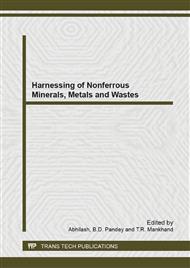p.33
p.45
p.55
p.65
p.73
p.81
p.93
p.117
p.123
Biphasic Leaching Operation for the GMDC Polymetallic Bulk Concentrate
Abstract:
A biphasic leaching operation was employed for the extraction of copper and zinc from the GMDC polymetallic bulk concentrate (PBC). Biogenerated ferric was used in cyclic manner for fed batch metal extractions from the PBC for four cycles under the pre-optimized conditions. Zn extraction was gradually decreased with each succeeding fed-batch cycle and it resulted in 67.89, 62.46, 47.37 and 14.74% of Zn extraction in 1st, 2nd, 3rd and 4th cycle respectively. In case of copper the extraction pattern was 86.63, 81.98, 75.58 and 46.51% Cu extraction in 1st, 2nd, 3rd and 4th cycle respectively. The leachate generated in each cycle was added in 15.0 L down flow packed bed column reactor having biofilm of developed consortium SR-BH-L for the ferrous bioregeneration and the obtained maximum IOR was 2650 mg/L/h. Overall results indicated that use of bioregenerated ferric iron from the leachate yielded as high as 52.2 and 2.6 g/L Zn and Cu respectively in the solution at the end of 4th cycle. This metal concentration in the leachate is quite acceptable for economical solvent extraction process.
Info:
Periodical:
Pages:
117-121
Citation:
Online since:
November 2013
Authors:
Price:
Сopyright:
© 2014 Trans Tech Publications Ltd. All Rights Reserved
Share:
Citation:


